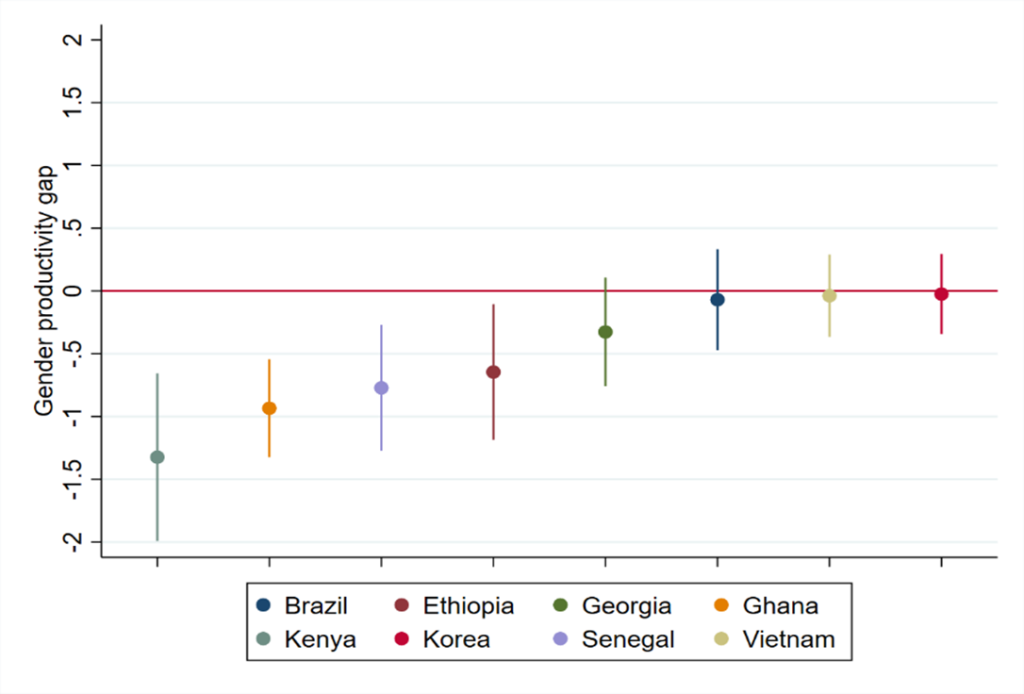Photo: K M Asad / World Bank
Authors: Xavier Cirera, Marcio Cruz, Antonio Martins-Neto, Kyung Min Lee and Caroline Nogueira
Women often lack access to inclusive and transformative technology due to socio-economic barriers and cultural norms, as recognized by the 2023 United Nations International Women’s Day theme “DigitALL: Innovation and technology for gender equality.” This digital divide can perpetuate gender inequalities in women’s entrepreneurship and business success.
New evidence from a forthcoming study demonstrates how technology can help women-led businesses become more productive. By analyzing the use of more than 200 technologies in representative samples of firms from nine countries at different income levels, the World Bank’s Firm Adoption of Technology (FAT) survey suggests that technology can reduce the difference in productivity between women- and men-led businesses.
Why is there a gender productivity gap?
Despite progress in joining the workforce, women encounter considerable barriers including: reaching high-level managerial positions, holding less than 5 percent of top executive positions in the US and Latin America. Even when women do attain leadership roles, a growing literature highlights differences in performance between businesses managed by women and men. Although research illustrates women’s distinct management style and their ability to contribute to firms’ strategic decisions and success, societal factors create gender differences in firms’ assets and labor market practices, reducing the productivity of their businesses. Women are often disadvantaged when accessing credit, facing higher interest rates, lower loan approval rates, and challenges receiving public support.
How does the productivity gap relate to country income level?
Based on its sample of countries, the study finds that the productivity gap between women and men-led enterprises is substantial in lower-income economies and not statistically significant in higher-income countries (Figure 1). Women-led firms are about 77% times less productive in Kenya, 60% less productive in Ghana, and about 50% less productive in Ethiopia and Senegal. In contrast, the gender gap in labor productivity is not significantly different from zero in Brazil, Georgia, Korea, and Vietnam. These findings suggest that women-led businesses can catch up during economic growth.
Figure 1: The gender gap in labor productivity by country
Note: Figure presents coefficients for individual country regressions of the logarithm of labor productivity on a dummy of female top managers, controlling for sector and size group dummies and using sampling weights. Vertical bars show estimated 95% confidence interval.
How does technology affect the gap?
Our study looked at technology as a critical factor to help reduce the productivity gap. Figure 2 shows the marginal effects of technology sophistication on labor productivity for women- and men-led businesses separately, controlling for region, sector, size, and other characteristics of managers and firms. Panel (a) displays the marginal effects associated with the sophistication of general business function (GBF) technologies, or those used across all firms such as administration, supply chain management, marketing, sales, and payment, while Panel (b) shows the impact of sector-specific business function (SBF) technologies. These indices vary from 1 (use of rudimentary technology and manual processes) to 5 (use of frontier technologies).
Figure 2: Returns to technology use
|
(a) GBF technologies |
(b) SBF technologies |
Note: Figures (a) and (b) present predicted values of the logarithm of labor productivity for firms with and without female top managers (FTM) at different values of the GBF and SBF technology indices at the intensive margin. Estimates are based on 2SLS regressions with the regional share of FTM and female ownership as exogenous variables. In addition, estimates control for sector and regional dummies, formality, the logarithm of capital per worker, the logarithm of employment, and the management human capital index. Vertical bars show estimated 95% confidence interval. All estimates employ sampling weights.
Our findings indicate that women-led businesses tend to experience lower productivity returns from technologies when the technology sophistication level is low. However, they begin to catch up quickly as their sophistication level increases at the point where firms intensively use some machines that require human interaction (e.g., a computer with basic software), and the higher returns to technology increase with the digitalization of most business functions. These patterns hold true for both GBF and SBF technologies, suggesting that the intensive use of more sophisticated technologies helps women-managed businesses reduce the productivity gap.
Several factors may explain why these returns to technology tend to be larger for women-led businesses, although more research is needed. For example, women are often responsible for juggling multiple roles, and digital technologies might help them make efficient use of time.
The need to target women-led businesses in technology upgrading programs
Gender-inclusive approaches are an emerging area of focus in many technology upgrading programs. Given technology’s positive role in reducing the productivity gap, these programs should target women-led businesses and help get more women and girls engaged in STEM and engineering so that they have the skills to adopt technologies and succeed in digitally intensive sectors. Reducing this productivity gap will benefit both women and the entire economy.
This research took place as part of programmatic work funded under the World Bank’s Jobs After Covid Innovation challenge. The Jobs After Covid Innovation Challenge supports diagnoses and solutions to jobs challenges through country-based innovation challenge competitions.







